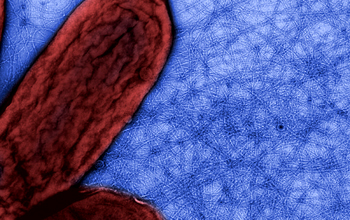Multimedia Gallery
Bacteria Synthesizing Network of Protein Nanofilaments
A transmission electron micrograph of Geobacter sulfurreducens cells synthesizing a network of protein nanofilaments that exhibit metallic-like conductivity.
More about this image
Researchers at the University of Massachusetts Amherst discovered a fundamental, previously unknown property of microbial nanowires in the bacterium G. sulfurreducens that allows electron transfer across long distances and could revolutionize nanotechnology and bioelectronics. The discovery was made by lead microbiologist Derek Lovley and physicists Mark Tuominen, Nikhil Malvankar and colleagues. The researchers say that networks of bacterial filaments, known as microbial nanowires because they conduct electrons along their length, can move charges as efficiently as synthetic, organic, metallic nanostructures, and they can do it over remarkable distances, thousands of times the bacterium's length. The finding may one day lead to cheaper, less-toxic nanomaterials for biosensors.
The research was supported in part by the National Science Foundation (grant CMMI 05-31171). To learn more, see the UMass-Amherst news story UMass-Amherst research team discovers new conducting properties of bacteria-produced wires. (Date of Image: June 2011)
Credit: Anna Klimes and Ernie Carbone, UMass-Amherst
See other images like this on your iPhone or iPad download NSF Science Zone on the Apple App Store.
Images and other media in the National Science Foundation Multimedia Gallery are available for use in print and electronic material by NSF employees, members of the media, university staff, teachers and the general public. All media in the gallery are intended for personal, educational and nonprofit/non-commercial use only.
Images credited to the National Science Foundation, a federal agency, are in the public domain. The images were created by employees of the United States Government as part of their official duties or prepared by contractors as "works for hire" for NSF. You may freely use NSF-credited images and, at your discretion, credit NSF with a "Courtesy: National Science Foundation" notation.
Additional information about general usage can be found in Conditions.
Also Available:
Download the high-resolution JPG version of the image. (3.6 MB)
Use your mouse to right-click (Mac users may need to Ctrl-click) the link above and choose the option that will save the file or target to your computer.

